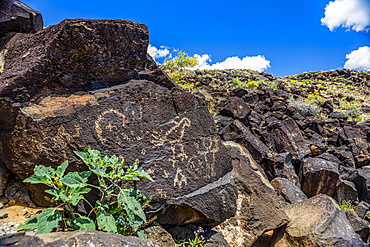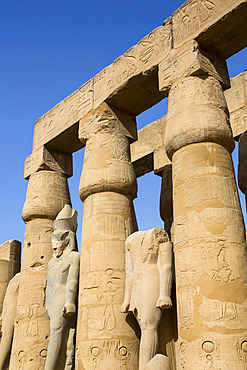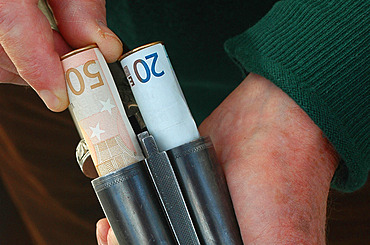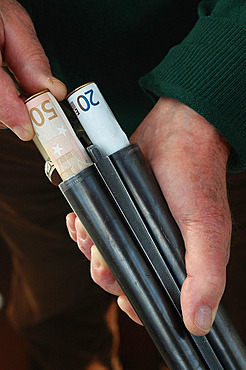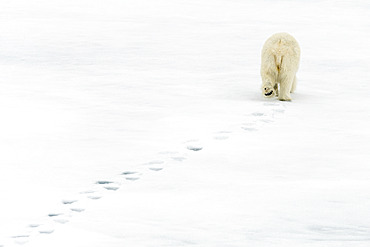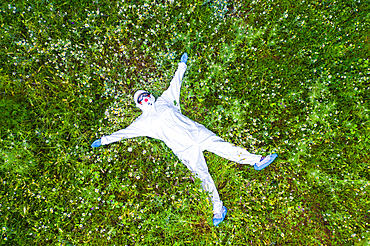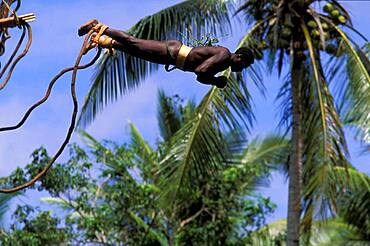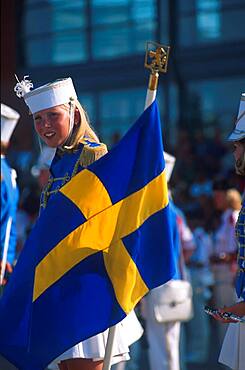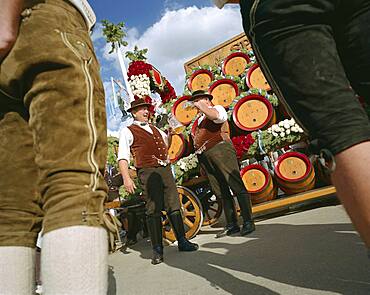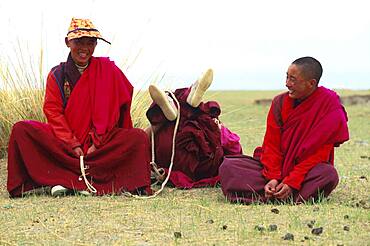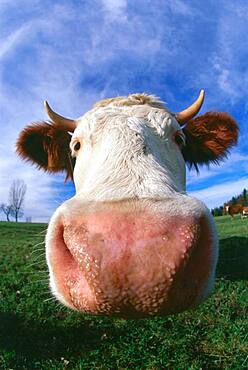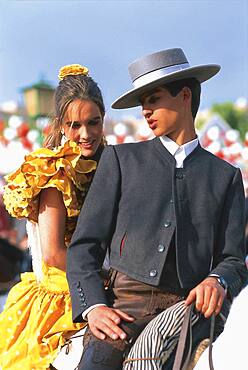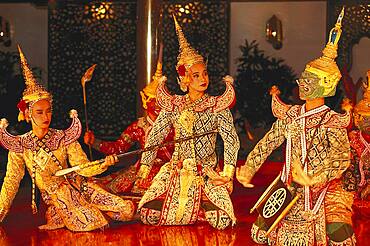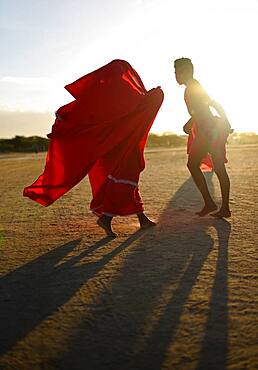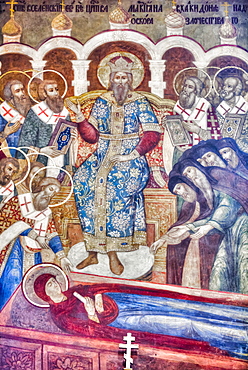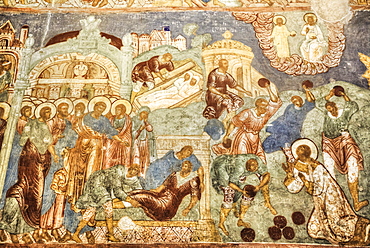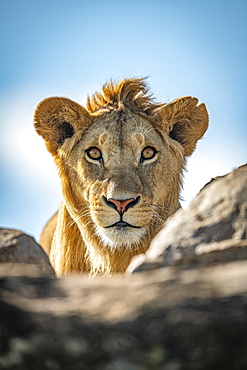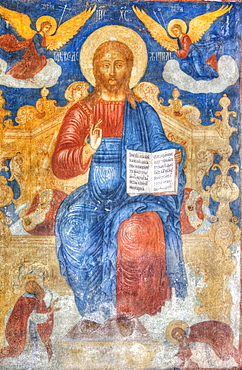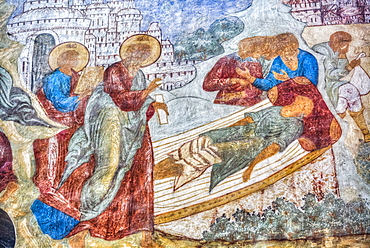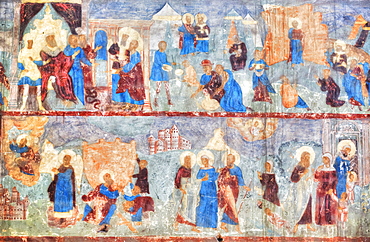Recent searches
Loading...
1116-50665 - Relief of Pharaohs, Tomb of Ramses V & VI, KV9, Valley of the Kings, UNESCO World Heritage Site; Luxor, Egypt
1116-51841 - Interior Fresco, St George Church Mirauti, 1375; Suceava, Suceava County, Romania
1116-51843 - Interior Fresco, St George Church Mirauti, 1375; Suceava, Suceava County, Romania
1116-51861 - Exterior frescoes, portion of 'Last Judgement', Voronet Monastery, 1487; Gura Humorului, Suceava County, Romania
1116-51027 - Petroglyphs on volcanic rock with sagebrush in Piedras Marcadas Canyon, Petroglyph National Monument on a sunny, spring afternoon; Albuquerque, New Mexico, United States of America
1116-51030 - Petroglyphs on volcanic rock in Piedras Marcadas Canyon, Petroglyph National Monument on a sunny, spring afternoon; Albuquerque, New Mexico, United States of America
1116-51022 - Petroglyphs on volcanic rock surrounded by sagebrush in Piedras Marcadas Canyon, Petroglyph National Monument on a sunny, spring afternoon; Albuquerque, New Mexico, United States of America
1116-50660 - Columns in the Court of Ramses II, Luxor Temple, UNESCO World Heritage Site; Luxor, Egypt
860-290371 - France. Hunting. The European commission has adopted in january 2021 a ban on using lead 100m around any wetland in Europe. In the future, the lead will be totally banned as 6000 tons of lead is put into nature by hunters every year. There is already new anmunitions with zinc, steel, tungsten and bismuth but much more expansive than lead.
860-290372 - France. Hunting. The European commission has adopted in january 2021 a ban on using lead 100m around any wetland in Europe. In the future, the lead will be totally banned as 6000 tons of lead is put into nature by hunters every year. There is already new anmunitions with zinc, steel, tungsten and bismuth but much more expansive than lead.
860-290111 - Polar bear (Ursus maritimus) wandering alone on the pack ice, leaving its footprints in the snow, arctic ocean off the coast of Spitsbergen.
809-8269 - Mosaic floor with Christian symbolism, 4th century, Patriarchal Basilica of Aquileia, UNESCO World Heritage Site, Aquileia, Friuli Venezia Giulia, Italy, Europe
1350-3494 - Person with a safety suit in a forest area. Ayegui, Navarre, Spain, Europe
1350-3492 - Person with a safety suit lying down in a flowers carpet in a forest area. Ayegui, Navarre, Spain, Europe
1350-3493 - Person with a safety suit in a forest area. Ayegui, Navarre, Spain, Europe
1113-105382 - Mountain guide in crevassedes, Brokarjoekull Glacier, Island
1113-105352 - Yad Vashem, stone with hebrew characters, holocaust memorial, Jerusalem, Israel
1113-105349 - Local man bungee jumping from a platform, ritual, Vanuatu, Polynesia, Asia
1113-105425 - Sand yachting, St. Peter Ording, North Sea Schleswig-Holstein, Germany
1113-105381 - Painted sign of a bull in remoted landscape, Andalusia, Spain, Europe
1113-105427 - Young woman in a bar, Kreuzberg, Berlin, Germany
1113-105434 - Two parachutists in ultralight airplane
1113-105401 - Blond girl with swedish ensign, Goeteborg, Sweden, Europe
1113-105426 - Two young women drinking beer, Berlin, Germany
1113-105383 - Entrainment of the hosts, Oktoberfest, Munich, Bavaria
1113-105402 - Laughing tibetan monks, Qinghai, China, Asia
1113-105447 - Booth with heart shaped gingerbreads, Oktoberfest, Munich, Bavaria, Germany
1113-105361 - Gold seekers at a river, Nha Trang, Vietnam, Asia
1113-105380 - Couple in traditional costumes on a horse, Feria de Abril, Sevilla, Andalusia, Spain, Europe
1113-105379 - Buddha's eyes in a temple, Kathmandu, Nepal, Asia
1113-105371 - Old men sitting in front of a building, Troodos mountains, Pano Platres, Cyprus, Europe
1113-105362 - Dancers in traditional costumes, Oriental Hotel, Bangkok, Thailand, Asia
1113-105368 - Baguettes and loafs of bread at a bakery, Drome, France, Europe
1350-1865 - Yonna dance, also called Chichamaya, carries a considerable symbolic charge for the Wayuu indigenous people of Colombia, representing three basic principles for this tribal group: Social equality, collective solidarity and the improvement of relations between the human being and the Cosmos.
1350-1859 - Yonna dance, also called Chichamaya, carries a considerable symbolic charge for the Wayuu indigenous people of Colombia, representing three basic principles for this tribal group: Social equality, collective solidarity and the improvement of relations between the human being and the Cosmos.
1350-1871 - Yonna dance, also called Chichamaya, carries a considerable symbolic charge for the Wayuu indigenous people of Colombia, representing three basic principles for this tribal group: Social equality, collective solidarity and the improvement of relations between the human being and the Cosmos.
1350-1860 - Yonna dance, also called Chichamaya, carries a considerable symbolic charge for the Wayuu indigenous people of Colombia, representing three basic principles for this tribal group: Social equality, collective solidarity and the improvement of relations between the human being and the Cosmos.
1350-1861 - Yonna dance, also called Chichamaya, carries a considerable symbolic charge for the Wayuu indigenous people of Colombia, representing three basic principles for this tribal group: Social equality, collective solidarity and the improvement of relations between the human being and the Cosmos.
1350-1862 - Yonna dance, also called Chichamaya, carries a considerable symbolic charge for the Wayuu indigenous people of Colombia, representing three basic principles for this tribal group: Social equality, collective solidarity and the improvement of relations between the human being and the Cosmos.
1350-1866 - Yonna dance, also called Chichamaya, carries a considerable symbolic charge for the Wayuu indigenous people of Colombia, representing three basic principles for this tribal group: Social equality, collective solidarity and the improvement of relations between the human being and the Cosmos.
1350-1870 - Yonna dance, also called Chichamaya, carries a considerable symbolic charge for the Wayuu indigenous people of Colombia, representing three basic principles for this tribal group: Social equality, collective solidarity and the improvement of relations between the human being and the Cosmos.
1350-1868 - Yonna dance, also called Chichamaya, carries a considerable symbolic charge for the Wayuu indigenous people of Colombia, representing three basic principles for this tribal group: Social equality, collective solidarity and the improvement of relations between the human being and the Cosmos.
1350-1858 - Yonna dance, also called Chichamaya, carries a considerable symbolic charge for the Wayuu indigenous people of Colombia, representing three basic principles for this tribal group: Social equality, collective solidarity and the improvement of relations between the human being and the Cosmos.
1350-1869 - Yonna dance, also called Chichamaya, carries a considerable symbolic charge for the Wayuu indigenous people of Colombia, representing three basic principles for this tribal group: Social equality, collective solidarity and the improvement of relations between the human being and the Cosmos.
1350-1863 - Yonna dance, also called Chichamaya, carries a considerable symbolic charge for the Wayuu indigenous people of Colombia, representing three basic principles for this tribal group: Social equality, collective solidarity and the improvement of relations between the human being and the Cosmos.
1350-1864 - Yonna dance, also called Chichamaya, carries a considerable symbolic charge for the Wayuu indigenous people of Colombia, representing three basic principles for this tribal group: Social equality, collective solidarity and the improvement of relations between the human being and the Cosmos.
1350-1867 - Yonna dance, also called Chichamaya, carries a considerable symbolic charge for the Wayuu indigenous people of Colombia, representing three basic principles for this tribal group: Social equality, collective solidarity and the improvement of relations between the human being and the Cosmos.
1116-49392 - Ethiopian Orthodox crosses, Axum, Tigray District, Ethiopia
1116-49431 - Don Jaun Rose (Rosa rugosa) on a black background
1116-49270 - Shadow of the Star of David on the ground, Sephardic Hebrew Center, Vedado, Havana, Cuba
1116-49390 - Ethiopian Orthodox ecclesiastical mural, depicting the Virgin and Child, in the interior of the Cathedral of Tsion Maryam (Our Lady Mary of Zion), built during the reign of Emperor Fasilides, Axum, Tigray Region, Ethiopia
1116-49389 - Ethiopian Orthodox cross atop of the Cathedral of Tsion Maryam (Our Lady Mary of Zion), Axum, Tigray Region, Ethiopia
1116-49984 - Fresco, Holy Formation Cathedral, Trinity Sergius Lavra Monastery complex; Sergiev Posad, Moscow Oblast, Russia
1116-50023 - Fresco in the Church of St John the Baptist; Yaroslavl, Yaroslavl Oblast, Russia
1116-50173 - Frescoes, St Johns Forerunners Parish; Athens, Greece
1116-49989 - Fresco, Holy Formation Cathedral, Trinity Sergius Lavra Monastery complex; Sergiev Posad, Moscow Oblast, Russia
1116-50166 - Fresco, Transfiguration Cathedral, Monastery of St Euthymius; Suzdal, Vladimir Oblast, Russia
1116-50157 - Fresco, Miracle-Image of the Saviour Church, Kremlin, Golden Ring; Rostov Veliky, Yaroslavl Oblast, Russia
1116-50018 - Church of Elijah the Prophet, fresco on the wall of Elijah's ascension into heaven in a whirlwind; Yaroslavl, Yaroslavl Oblast, Russia
1116-50185 - Fresco, The Resurrection Church on the Debra; Kostroma, Kostroma Oblast, Russia
1116-50360 - A young male lion (Panthera leo) pokes his head above a rocky ledge under a blue sky. He has a short mane and is staring straight at the camera. Klein's Camp, Serengeti National Park; Tanzania
1116-50158 - Fresco, Miracle-Image of the Saviour Church, Kremlin, Golden Ring; Rostov Veliky, Yaroslavl Oblast, Russia
1116-50017 - Church of Elijah the Prophet, with colourful frescos on the wall depicting Biblical scenes of harvest; Yaroslavl, Yaroslavl Oblast, Russia
1116-50013 - Church of Elijah the Prophet, with colourful frescoes on the walls depicting Biblical scenes; Yaroslavl, Yaroslavl Oblast, Russia
1116-50164 - Fresco, Gate-Church of the Resurrection (1670), Kremlin, Golden Ring; Rostov Veliky, Yaroslavl Oblast, Russia
1116-50114 - Fresco, Holy Monastery of Varlaam, Meteora; Thessaly, Greece
1116-50186 - Fresco, Troitse-Sergiyev Varnitskiy Monastery, near Rostov Veliky, Golden Ring; Yaroslavl Oblast, Russia
1116-50168 - Interior Fresco, Cathedral of the Nativity (1222), Kremlin; Suzdal, Vladimir Oblast, Russia
1116-50276 - Cuban flag and blue car on the streets of Havana; Havana, Cuba
1116-49998 - Fresco, Church of Elijah the Prophet; Yaroslavl, Yaroslavl Oblast, Russia
1116-50026 - Fresco in the Church of St John the Baptist; Yaroslavl, Yaroslavl Oblast, Russia
1116-50093 - World War One memorial of a soldier with rifle and poppy; Wark, Northumberland, England
1116-50025 - Fresco in the Church of St John the Baptist; Yaroslavl, Yaroslavl Oblast, Russia
1116-50174 - Frescoes, St Johns Forerunners Parish; Athens, Greece
1116-50027 - Fresco in the Church of St John the Baptist; Yaroslavl, Yaroslavl Oblast, Russia
1116-50184 - Fresco, The Resurrection Church on the Debra; Kostroma, Kostroma Oblast, Russia
1116-50163 - Fresco, Gate-Church of the Resurrection (1670), Kremlin, Golden Ring; Rostov Veliky, Yaroslavl Oblast, Russia
1116-49988 - Frescoes, Holy Dormition Cathedral, Trinity Sergius Lavra Monastery complex; Sergiev Posad, Moscow Oblast, Russia
1116-50022 - Fresco in the Church of St John the Baptist; Yaroslavl, Yaroslavl Oblast, Russia
1116-50171 - Original Fresco, St Demetrius Cathedral (1194-97); Vladimir, Russia
1116-50021 - Fresco in the Church of St John the Baptist; Yaroslavl, Yaroslavl Oblast, Russia
1116-50172 - Frescoes, St Johns Forerunners Parish; Athens, Greece
1116-50167 - Fresco, Transfiguration Cathedral, Monastery of St Euthymius; Suzdal, Vladimir Oblast, Russia
1116-50019 - Church of Elijah the Prophet, with ornate arched doorways and colourful frescoes; Yaroslavl, Yaroslavl Oblast, Russia
1116-50010 - Fresco, New Testament Trinity, Spassky Monastery; Yaroslavl, Yaroslavl Oblast, Russia
1116-50004 - St John the Baptist Church, Trinity Lavra of St. Sergius; Sergiev Posad, Moscow Oblast, Russia
1116-50159 - Fresco, Gate-Church of St John, Kremlin, Golden Ring; Rostov Veliky, Yaroslavl Oblast, Russia
1116-49996 - Fresco, Church of Elijah the Prophet; Yaroslavl, Yaroslavl Oblast, Russia
1116-49985 - Fresco, Holy Formation Cathedral, Trinity Sergius Lavra Monastery complex; Sergiev Posad, Moscow Oblast, Russia
1116-49987 - Fresco, Holy Formation Cathedral, Trinity Sergius Lavra Monastery complex; Sergiev Posad, Moscow Oblast, Russia
1116-50005 - Fresco, St Michael the Archangel Church; Yaroslavl, Yaroslavl Oblast, Russia
1116-50020 - Church of Elijah the Prophet, with ornate arched doorway and colourful frescoes; Yaroslavl, Yaroslavl Oblast, Russia
1116-50131 - Fresco, St Johns Forerunners Parish; Athens, Greece
1116-50015 - Church of Elijah the Prophet, with colourful frescoes on the walls depicting Biblical scenes; Yaroslavl, Yaroslavl Oblast, Russia
1116-49997 - Fresco, Church of Elijah the Prophet; Yaroslavl, Yaroslavl Oblast, Russia
1116-49990 - Frescoes, Holy Dormition Cathedral, Trinity Sergius Lavra Monastery complex; Sergiev Posad, Moscow Oblast, Russia
1116-50156 - Fresco, Miracle-Image of the Saviour Church, Kremlin, Golden Ring; Rostov Veliky, Yaroslavl Oblast, Russia






